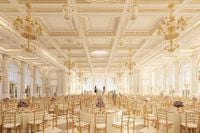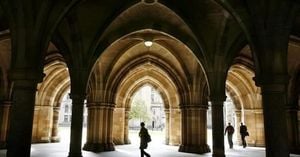In a year marked by bold statements and even bolder renovations, President Donald Trump has embarked on a sweeping transformation of the White House grounds, unveiling a vision of presidential grandeur that has both dazzled and divided observers. The most eye-catching of these projects—a colossal new ballroom, set to eclipse the size of the White House itself—has become the latest symbol of Trump’s penchant for opulence and spectacle.
According to CBS News, renderings of the new ballroom reveal a gold-tinged, 90,000-square-foot structure that would dwarf the White House’s already sizeable 50,000 square feet. The images, which circulated widely on social media, show a building reminiscent of the Gilded Age, bristling with architectural flourishes and a scale that leaves little to the imagination. The ballroom’s footprint, as highlighted in the renderings, will dominate the White House lawn, forever altering the landscape of America’s most iconic residence.
The White House announced the ballroom project in July 2025, framing it as the answer to a century-and-a-half-old wish. “For 150 years, Presidents, Administrations, and White House Staff have longed for a large event space on the White House complex that can hold substantially more guests than currently allowed,” the statement read. “President Donald J. Trump has expressed his commitment to solving this problem on behalf of future Administrations and the American people.”
Construction on the ballroom began in early September 2025, with a staggering price tag of $200 million. Despite the scale and cost, the project has so far relied entirely on private funding. Major corporate donors have stepped forward, including tech giant Google, tobacco powerhouse R.J. Reynolds, consulting firm Booz Allen Hamilton, defense contractor Lockheed Martin, and data analytics company Palantir. Their financial support has raised eyebrows, prompting questions about corporate influence and the symbolism of such lavish spending on presidential infrastructure.
Trump himself has been anything but shy about his enthusiasm for the project. In July, he declared, “They’ve wanted a ballroom at the White House for more than 150 years, but there’s never been a president that’s good at ballrooms.” It was a characteristic flourish—equal parts bravado and branding. Even when asked about the tragic assassination of conservative activist Charlie Kirk in September, Trump pivoted to the ballroom, saying, “And by the way, right there you see all the trucks; they just started construction of the new ballroom for the White House. Which is something they’ve been trying to get as you know for about 150 years, and it’s gonna be a beauty, it’ll be an absolutely magnificent structure.”
This ballroom, however, is only the most conspicuous of a series of renovations that have reshaped the White House in recent months. As reported by HuffPost, the past eight months have seen a whirlwind of changes: the Oval Office has been gilded, the Rose Garden’s grassy core paved over, and two towering flagpoles erected. Each alteration has carried Trump’s unmistakable signature—bold, gleaming, and unapologetically grand.
On Thursday, September 25, 2025, Trump announced the completion of yet another project: the renovation of the Palm Room. Once a light-filled passageway between the White House residence and the West Wing, the Palm Room now boasts a pristine white marble floor and ornate chandeliers, replacing the previous soft grey tiles and understated lighting. Trump, ever eager to take personal credit, posted a photo of the new lobby to his Truth Social page, writing, “New lobby leading to Oval Office — Magnificent marble floor, compliments of President Donald J. Trump!”
The president has stated that these renovations have been financed both with his own funds and with donations from his supporters. While the White House has not clarified whether certain furnishings, like benches and plants, have been permanently removed or simply not yet replaced, the shift in style is unmistakable. Gone are the understated touches and greenery that once characterized the space; in their place, gleaming surfaces and elaborate fixtures dominate the scene.
This penchant for replacing plant life with objects has been a recurring theme. The Rose Garden, once famed for its lush green expanse, was paved over during the summer of 2025, ostensibly to prevent visitors’ heels from sinking into the dirt. An ivy plant that had graced the Oval Office mantle for decades was also removed, replaced by a growing collection of golden trophies and objets d’art—further evidence, critics say, of a shift from organic beauty to ostentatious display.
Supporters of the renovations argue that Trump is finally giving the White House the kind of event space and modern amenities it has long lacked. “Previous presidents have wanted to do this for decades,” one administration official told CBS News. “President Trump is the only one with the vision and the will to make it happen.” For these backers, the new ballroom and marble halls are not just about style—they’re about functionality, security, and the ability to host larger state events that reflect America’s stature on the world stage.
But detractors see something different. For them, these projects represent a retreat from the White House’s traditional role as “the people’s house.” The sheer scale and exclusivity of the new ballroom—likely accessible only to those with deep pockets or political connections—has fueled criticism that Trump is remaking the presidency in the image of his own private resorts, like Mar-a-Lago. As one commentator put it, “This kind of project is what Trump actually cares about. He’s more concerned with projecting opulence and pomp than he is about governing.”
The question of public access looms large. While the White House has always been a symbol of democracy and openness, the addition of a $200 million, privately funded ballroom next door has prompted fears that ordinary Americans will be left out—unless, as some have wryly noted, they can pony up a couple hundred million dollars themselves.
Amid these debates, the renovations continue apace, transforming both the physical space and the symbolic meaning of the presidency. Whether these changes will endure beyond Trump’s tenure—or whether future administrations will embrace or dismantle his gilded legacy—remains to be seen. For now, one thing is clear: the White House has never looked quite like this before, and the echoes of Trump’s transformation will linger long after the marble dust has settled.
With every new chandelier and gilded surface, the White House is becoming less a house of the people and more a monument to one man’s vision of presidential grandeur. Only time will tell whether history judges these changes as bold improvements or costly extravagances.




